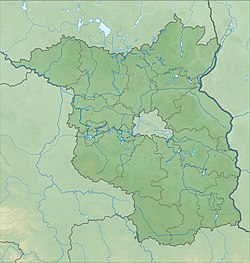Germanic-Slavic settlement of Berlin-Marzahn
Coordinates: 52 ° 32 ′ 21 ″ N , 13 ° 33 ′ 51 ″ E
| Germanic-Slavic settlement of Berlin-Marzahn | ||
|---|---|---|
| location | Berlin , Germany | |
| Location | Alt-Marzahn | |
|
|
||
| When | early Germanic settlement, 5th to 1st century BC Chr. Germanic settlement, 3rd or 4th century to the 5th century. BC. Slavic settlement, v from the 7th or 8th century. Chr. |
|
| Where | Alt-Marzahn , Berlin-Marzahn / Berlin | |
The remains of a Germanic and Slavic settlement were excavated from 1976 to 1979 in Berlin-Marzahn , on the south-eastern edge of Alt-Marzahn , on the southern edge of the Rohrpfuhl .
Three phases could be distinguished. The first two phases belong to a Germanic settlement, while Slavs settled here from the seventh or eighth century . It is not certain whether there was continuity of settlements, late Germanic finds in the vicinity date back to the 6th century. The Slavs appear exactly in the Germanic settlements and have also retained the Germanic names of waters.
The examined Germanic settlement dates from the fifth to the first century BC. There were three farmsteads with 20 m long long houses and smaller farm buildings as well as garbage pits and an oven. Pottery, iron processing and bronze casting could be demonstrated in terms of handicraft. About 250 m from the settlement an urn grave field with 30 burials came to light.
The second settlement was probably inhabited from the third or fourth century to the fifth century AD, although the excavations could only cover a part. These are the remains of about six buildings and huts that are to be understood as commercial buildings. There were stoves and open fireplaces, garbage pits and a well. The main find material was ceramics, there was also evidence of spinning and weaving, and possibly iron or woodworking. Overall, the yield of small finds was not very large. The remains of the settlement indicate a largely egalitarian village community.
From the seventh century, Slavs settled in the area, the finds of which are the oldest in the area. Settlement pits were found, but no remains of house floor plans. Most of the ceramics came to light in the pits. Two wells could be excavated. Slavs continued to use Germanic wells by building up more wood. Tools that were still available were found.
literature
- Kai Schirmer, René Bräunig: 9,000 years of history under your feet.
- Heinz Seyer: The late Germanic settlement of Berlin-Marzahn. In: Ethnographisch-Archäologische Zeitschrift , 43 (2002), pp. 245–274.
- Adrian von Müller: When Berlin was still in the tropics. From the ice age to the medieval city. Bastei Lübbe, Bergisch Gladbach 1986, ISBN 3-404-64094-2 , pp. 276-281 (chapter Germanic people and Slavs - a peaceful coexistence ).
Web links
Individual evidence
- ↑ Günter Peters: Historical development of the Angerdorf Marzahn. (PDF; 338 kB) (No longer available online.) Heimatverein Marzahn, 2000, p. 2 , formerly in the original ; retrieved on April 4, 2011 : “The original Marzahners lived on the former Rohrpfuhl near the Geißenweide over 2500 years ago and practiced agriculture and cattle breeding. Archaeologists discovered this during explorations during the development of the new building area southeast of today's Marzahn village center in the northern area of Kienbergstrasse in the mid-1970s. "
- ↑ TK25 sheet 3447 Friedrichsfelde (1903). (No longer available online.) In: Geogreif - map collection. Archived from the original on October 11, 2012 ; accessed in April 2011 . Info: The archive link was inserted automatically and has not yet been checked. Please check the original and archive link according to the instructions and then remove this notice.
